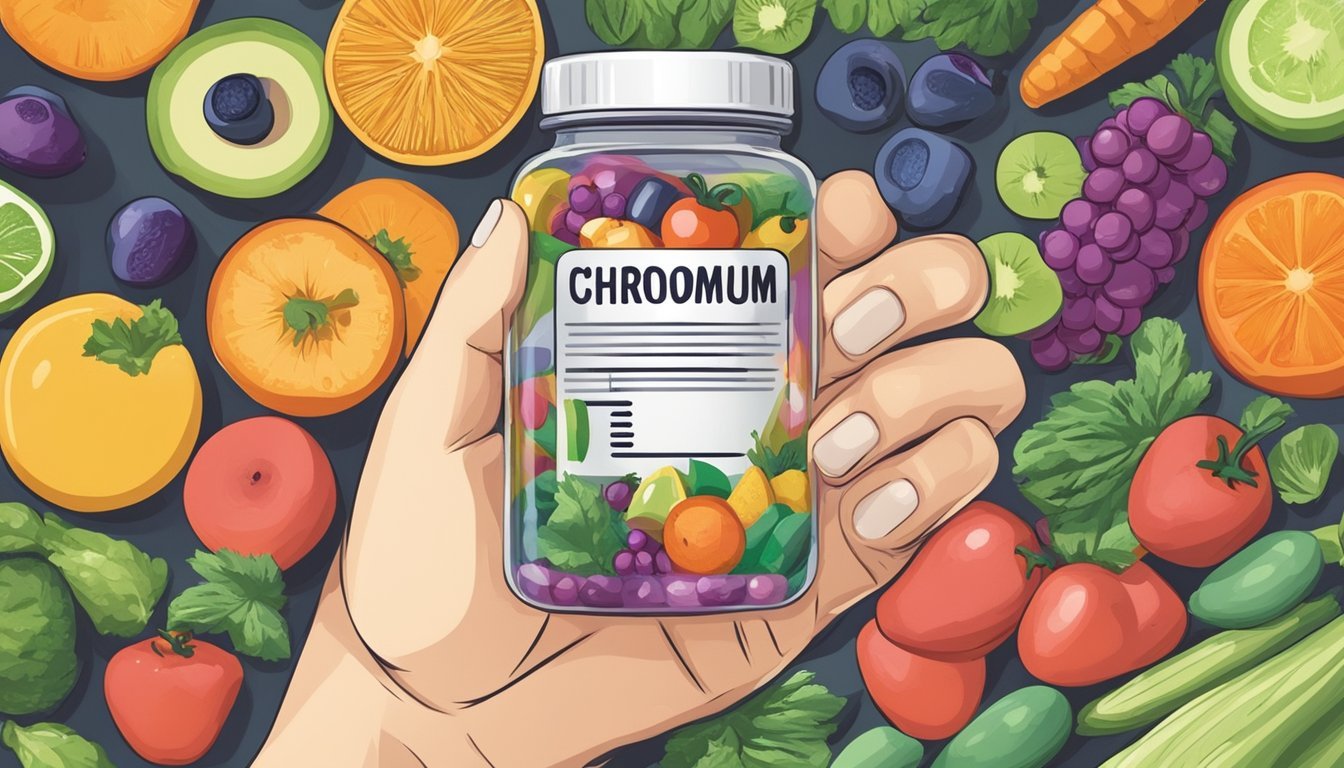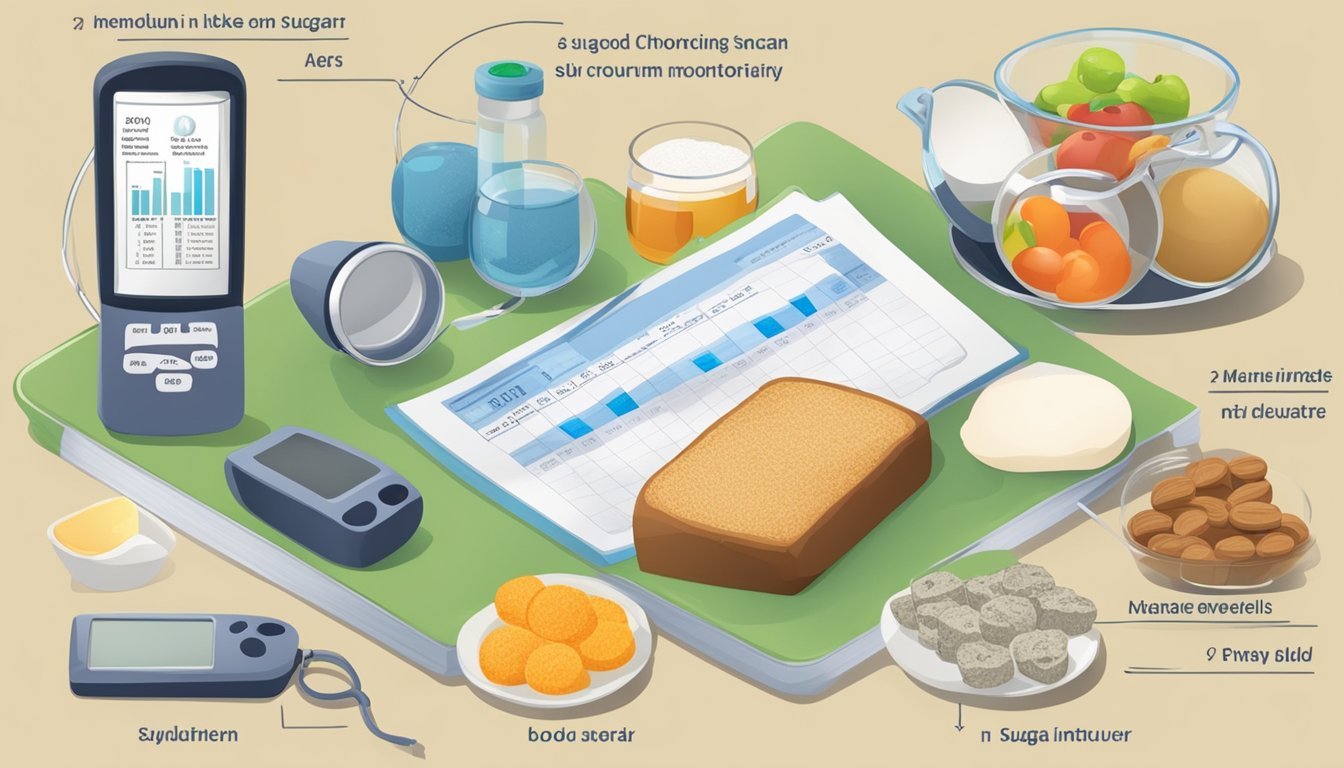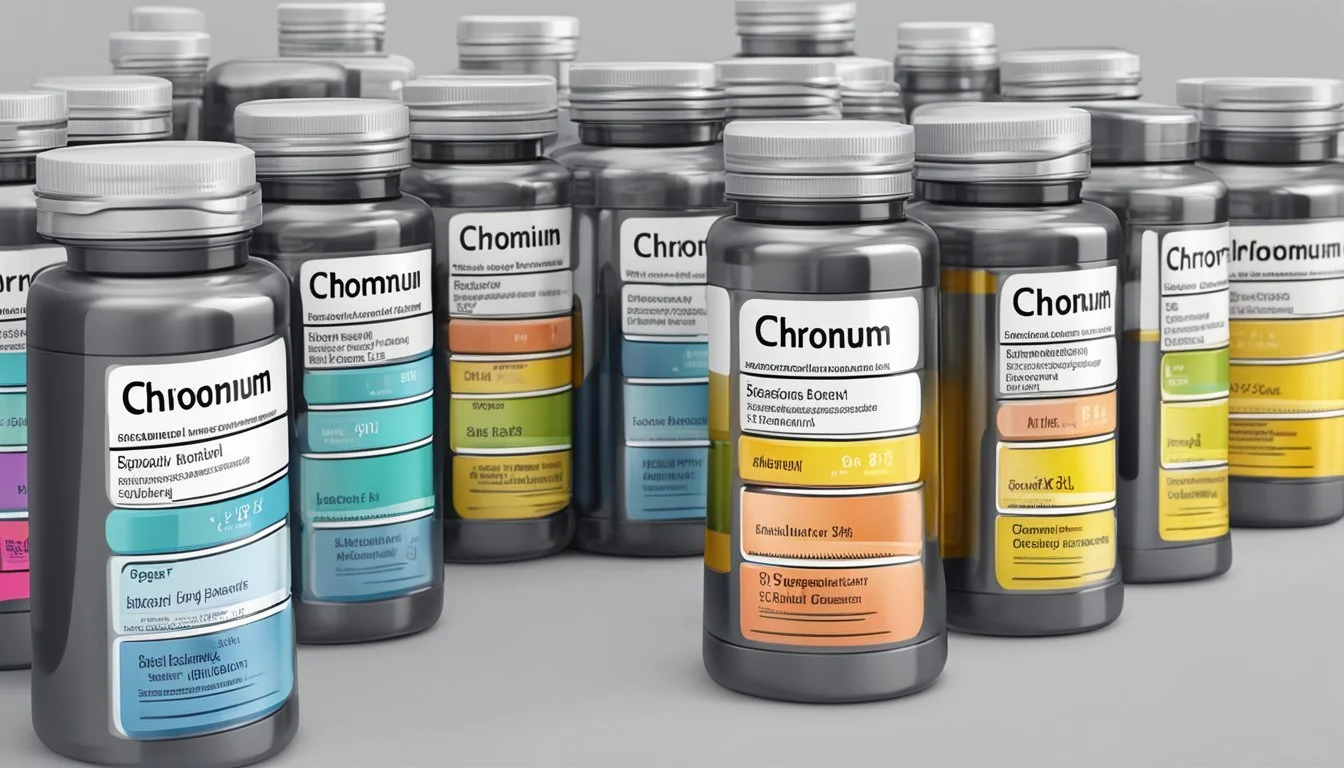How much chromium should you consume for optimal blood sugar regulation?
Chromium plays an essential role in carbohydrate, fat, and protein metabolism by enhancing the action of insulin. Understanding the significance of chromium for blood sugar control has been the subject of numerous studies, as maintaining a healthy blood sugar level is crucial for preventing and managing diabetes. The adequate intake of chromium has been identified as a factor with potential benefits in regulating blood sugar.
Research has found that chromium supplementation can improve blood glucose control for some individuals. For instance, studies have indicated that taking 600 micrograms of chromium per day may offer improvements in blood sugar levels. However, it's important to note that results can vary, and in some cases, there might not be a direct correlation between chromium supplementation and cholesterol level changes.
Daily chromium requirements are generally met through a balanced diet, with foods such as whole grains, nuts, green beans, and meats providing natural sources of this trace mineral. For those considering chromium supplementation specifically for blood sugar regulation, it is essential to consult with a healthcare provider to determine the appropriate dosage and to evaluate any potential benefits or risks based on individual health factors.
Understanding Chromium
Chromium is a trace mineral that is considered essential for human health. It primarily exists in two forms: trivalent chromium (Cr^3+), which is biologically active and safe for consumption, and hexavalent chromium (Cr^6+), which is toxic and a known carcinogen. The form typically involved in glucose metabolism and insulin function is trivalent chromium.
This nutrient plays a significant role in the metabolism of nutrients through its impact on the hormone insulin. Insulin is critical for the body's use of glucose for energy. Chromium aids in enhancing insulin's effectiveness, making it pivotal for maintaining normal blood glucose levels.
Although it is an essential mineral, the human body requires chromium in small amounts. It is found naturally in various foods such as:
Whole grains
Fresh fruits and vegetables
Meat and seafood
Nuts and legumes
Commercial dietary supplements also provide chromium, often as chromium picolinate, which can improve its absorption rate in the body. While deficiency in this nutrient is generally rare, those with diabetes or at risk for the condition may be more attentive to their chromium intake due to the mineral's influence on carbohydrate, fat, and protein metabolism.
The recommended daily intake of chromium has not been precisely defined, as it depends on several factors such as age, sex, and overall health. It's essential to consult with healthcare providers before starting any supplementation, as they can offer guidance based on individual health needs and objectives.
Chromium's Role in Blood Sugar Control
Chromium is a trace mineral essential for insulin function and glucose metabolism. This section discusses its specific roles and implications for blood sugar stability.
Insulin and Glucose Metabolism
The body requires chromium to metabolize carbohydrates, fats, and proteins effectively. It influences blood sugar control by enhancing the action of insulin, a hormone critical for the transport and regulation of glucose in the bloodstream. Chromium assists insulin in binding to cells, thereby improving insulin sensitivity and facilitating glucose uptake. This process is vital for maintaining steady blood sugar levels.
Implications for Diabetes Management
For individuals with type 2 diabetes or those managing prediabetes, chromium may have significant implications. By contributing to insulin sensitivity and helping counteract insulin resistance, chromium plays a role in the overall metabolism of blood sugar. Adequate chromium intake is important for people with diabetes to maximize insulin efficiency and improve blood sugar control. However, it should be noted that while supplementation has shown promise, not all studies have found chromium to be effective, and it should not replace conventional diabetes treatment.
Recommended Dietary Allowance
To ensure proper blood sugar control, it's important to consume the right amount of chromium. This section discusses the Adequate Intake (AI) levels set due to insufficient data for establishing a Recommended Dietary Allowance (RDA).
Adequate Intake Levels
The concept of Adequate Intake is used when there isn't enough evidence to establish a Recommended Dietary Allowance for a nutrient. For chromium, Adequate Intake (AI) levels have been determined to estimate a safe and daily dietary intake. Adults and adolescents' AI is set at 20 to 35 micrograms (mcg) per day, varying by age and sex.
Differences Between Genders and Age Groups
Chromium requirements differ between genders and age groups. Here is a breakdown of AI recommendations:
Children 1-3 years: 11 mcg/day
Children 4-8 years: 15 mcg/day
Males 9-13 years: 25 mcg/day
Females 9-13 years: 21 mcg/day
Males 14-18 years: 35 mcg/day
Females 14-18 years: 24 mcg/day
During pregnancy, the AI increases to 29-30 mcg/day, and during lactation, it further increases to 44-45 mcg/day.
For adult men, the AI is 30-35 mcg/day and for adult women, the AI is 20-25 mcg/day.
It is important to note that these levels are for general health maintenance and that individual requirements for blood sugar control may vary based on specific health conditions and should be discussed with a healthcare provider.
Sources of Chromium
Chromium is an essential trace mineral important for the metabolism of nutrients and insulin function. It can be obtained through certain foods and supplements. Knowing the various sources can help individuals manage their dietary chromium intake for blood sugar control.
Dietary Sources
Foods high in chromium contribute to the body's daily intake. They include:
Meat: Beef is particularly rich in chromium, and turkey and ham also provide this nutrient.
Vegetables: Green beans, lettuce, and other vegetables offer chromium in varying amounts.
Whole Grains: Whole wheat and other whole grains are known to be good sources.
Fruits: Consumption of apples and bananas can contribute to the intake of chromium.
Brewer’s Yeast: A notable supplement often used to boost chromium levels.
Here is a table showing some common foods and their approximate chromium content:
Food Item Approximate Chromium Content Beef, 3 oz 2 mcg Turkey, 3 oz 1.7 mcg Ham, 3 oz 0.6 mcg Whole Wheat Bread 0.4 mcg per slice Green Beans, 1/2 cup 1.1 mcg Apple 0.6 mcg Banana 1 mcg
Supplementation Options
For individuals who may need to supplement their chromium intake, there are various forms of chromium supplements available. The Food and Drug Administration (FDA) does not provide Recommended Dietary Allowances (RDA) for chromium, but suggests an adequate intake (AI) level.
Chromium Picolinate: A commonly used form that is widely available and used in many supplements.
Chromium Chloride: Another form often found in dietary supplements.
When considering supplementation, it's important for individuals to consult healthcare professionals and be aware of the dosage as excessive intake may cause negative health effects.
Health Benefits Beyond Blood Sugar
While chromium is primarily recognized for its role in blood sugar regulation, it also appears to confer additional health benefits related to weight management, heart health, and muscle metabolism.
Weight Management
Chromium may have a role in managing weight, particularly in cases of obesity and being overweight. While evidence is varied, some individuals may experience a modest effect in terms of weight loss when incorporating chromium supplements.
Heart Health and Cholesterol
Chromium is associated with heart health, potentially aiding in the management of blood cholesterol levels. Low levels of chromium could be linked to an increased risk of heart disease. Some studies suggest a beneficial effect on cholesterol, which is an important factor in managing metabolic syndrome and preventing heart disease.
Muscle Mass and Metabolism
In terms of body composition, chromium might contribute to muscle mass maintenance and development. Adequate chromium levels are essential for efficient metabolism and may assist in preventing muscle loss while promoting a leaner body mass in the context of exercise and proper diet.
Potential Risks and Side Effects
While chromium plays a role in blood sugar control, understanding its potential risks and side effects is crucial for safe supplementation. This section outlines how chromium may interact with certain medications and health conditions, and the risks associated with both chromium deficiency and toxicity.
Interactions with Medications and Conditions
Chromium supplements can interact with various medications and health conditions, which could potentially alter their effectiveness or lead to adverse effects. For individuals with diabetes, particularly those taking diabetes medications such as metformin, chromium may enhance the drug’s effect on blood sugar, necessitating close monitoring of blood glucose levels to avoid hypoglycemia. Similarly, those on levothyroxine for thyroid conditions should be aware that chromium may influence thyroid hormone levels and adjustment of medication might be needed.
People suffering from liver disease or kidney disease should exercise caution, as excessive chromium intake can exacerbate these conditions. Individuals taking antacids are also at risk as these can affect chromium absorption and metabolism.
Risks of Chromium Deficiency and Toxicity
Chromium deficiency can lead to impaired glucose tolerance and exacerbate the symptoms of polycystic ovary syndrome (PCOS), as chromium is involved in insulin signaling. However, the deficiency of this mineral is generally rare.
On the other hand, chromium toxicity can occur with high doses of chromium supplements. Symptoms of toxicity may include:
Liver damage
Kidney damage
Gastrointestinal issues
Dermatitis
Over-supplementation could lead to severe side effects, especially in individuals with pre-existing health conditions. It is essential to adhere to recommended dosages to avoid these adverse effects.
Clinical Evidence and Research
Research has shown diverse outcomes regarding chromium's role in blood sugar control, with several clinical trials and systematic reviews contributing to the ongoing scientific dialogue. The American Diabetes Association considers the evidence in this area while formulating guidelines.
Studies on Chromium and Blood Sugar Control
Clinical trials have investigated the effects of chromium on blood sugar levels, often measuring HbA1c—a robust marker of long-term glucose control. Results vary, with some trials indicating improved blood sugar regulation and others showing minimal effect. One trial observed the mean serum levels of chromium in patients with type 2 diabetes and found they were higher than previously reported, suggesting a potential impact of chromium on diabetic biomarkers. Research findings are influenced by factors such as the severity of diabetes, extent of obesity, and presence of insulin resistance among participants.
Investigations into Chromium Supplementation
Systematic reviews and meta-analyses offer a broader perspective by synthesizing data from numerous studies. A review comprising eight meta-analyses examined the relationship between chromium supplementation and glycemic control in 58 clinical trials. The conclusions drawn from these comprehensive analyses contribute significantly to the understanding of chromium's efficacy, although they also acknowledge inconsistencies across different trials. Randomized clinical trials are particularly valued for their rigor, assessing the effects of chromium in controlled settings and helping to determine its role in the prevention and treatment of cardiovascular diseases related to metabolic syndrome and blood sugar control.
Practical Considerations for Consumers
When considering chromium intake for blood sugar control, consumers should prioritize consulting with healthcare professionals and understanding the labels on chromium supplements. These steps will ensure safe and effective use of this essential nutrient.
Consulting Healthcare Providers
Consumers should consult with a healthcare provider or a registered dietitian before beginning a chromium supplement regimen. They can offer personalized advice, especially for individuals with an endocrine disorder, fertility concerns, or experiencing oxidative stress. This guidance is crucial, as the incorrect dosage may lead to unintended side effects such as headaches. Providers can also recommend natural sources of chromium, like turkey breast or grape juice, to incorporate into one's diet.
Understanding Supplement Labels
When selecting a chromium supplement in the market, consumers must carefully read and understand the supplement labels. Supplements may vary in dosage and form, so it's essential to choose one that matches the healthcare provider's recommendation. Look for key components that may enhance chromium absorption, like niacin (vitamin B3) and vitamin C as noted by sources. Additionally, consumers should note daily values and any warning of potential side effects to make an informed decision.
Environmental Factors and Chromium Availability
Environmental factors play a critical role in determining the availability of chromium in the soil, which subsequently affects the chromium content in various foods. Natural soil composition is influenced by the underlying rock from which the soil has formed. Areas with chromium-rich bedrock typically lead to higher levels of chromium in the soil.
Soil Health and Farming Practices:
Organic matter: Enhances chromium uptake in plants.
pH levels: Soil acidity can affect mineral availability.
Pollution: Industrial practices can lead to soil contamination.
Chromium Uptake by Plants:
Plants absorb chromium and other minerals from the soil to aid in processes such as the synthesis of carbohydrates, proteins, and fats. However, the specific chromium uptake mechanisms and the resulting concentrations in plant tissues are not uniform across different plant species.
Mining and Industrial Impact:
Industrial activities can lead to increased levels of chromium in soil, particularly in areas surrounding factories that engage in metal processing or the production and use of chromium-containing dyes and pigments. This can either raise or reduce chromium bioavailability for plant absorption, depending on the specific industrial processes and environmental controls in place.
In summary, environmental variables are instrumental in determining the levels of chromium available for human consumption through the food chain. These factors include the natural composition of the earth, the health of the soil, and the impact of industrial activities.
Future Perspectives in Chromium Research
Research on chromium as it relates to blood sugar control is ongoing, and the future perspectives within this field highlight several critical paths. Investigators continue to pursue a clearer understanding of chromium's role in metabolic processes, particularly concerning insulin resistance and glucose metabolism.
Methodology Refinement
Researchers are working to establish reliable methods to assess the body's chromium levels.
Consensus on effective doses of chromium for glucose management is needed.
It is important to determine the bioavailability of chromium supplements.
Population-Specific Studies
Future studies may focus on variations in chromium metabolism between Western and non-Western populations.
Identifying individuals who might be at risk for chromium deficiency is a priority.
Clinical Trials
Well-designed, long-term clinical trials are essential to evaluate the potential benefits of supplemental chromium in healthcare.
The trial outcomes may lead to personalized approaches in diabetes management.
Upcoming investigations will likely explore:
Supplemental Forms: The bioactive forms of chromium that offer the greatest efficacy.
Safety Profiles: Determining the long-term safety of supplemental chromium intake.
Healthcare Integration
A deeper integration into healthcare protocols for the use of chromium supplements could occur, contingent upon conclusive research findings.
By advancing this research, the scientific community aims to provide more definitive guidance for the use of chromium in managing blood sugar levels. This endeavor seeks to maximize patient outcomes, minimize risks, and contribute to the overall understanding of micronutrients in health and disease management.
Conclusion
Research indicates that chromium supplementation may improve blood sugar control in some individuals with type 2 diabetes. The optimal dose of chromium for blood sugar regulation appears to vary, but studies often utilize dosages ranging from 200 to 600 micrograms per day. It is essential to note that while some studies report a significant reduction in HbA1c levels with chromium supplementation, others show inconsistent results.
Individuals considering chromium supplementation should adhere to the following considerations:
Consult a Healthcare Provider: Before adding a chromium supplement to one's regimen, one should consult with a healthcare professional, particularly for those with diabetes or who are on blood sugar-lowering medications.
Dietary Sources: Chromium is present in a variety of foods such as egg yolks, whole-grain products, high-bran cereals, and certain meats, making a balanced diet a viable source of this mineral.
Supplementation: If choosing to supplement, individuals should look for reputable brands and avoid exceeding the upper limit of safe intake established by health authorities.
Monitor Blood Sugar Levels: Those with diabetes should monitor their blood sugar levels closely when taking chromium supplements to prevent potential hypoglycemia.
Safety and efficacy are paramount, thus while chromium may have a role in blood sugar control, it should be used judiciously and in concert with other diabetes management strategies under professional guidance.








